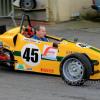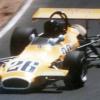Here in Brazil the DKWs made a good racing, there is rumours that Lotus was thinking to use Two Stroke DKW 1000 for Formula Jr. and Formula 3. DKWs engines reached almost 100 HP at that time, I believe more than BMC or Ford.
I never saw a regulation forbiden the use of these engines.
In East German they were used: http://www.500race.o...elkus Heinz.htm

Why didn't F3 and Formula Jr. use two-stroke engines?
#1

Posted 23 August 2015 - 16:12
Advertisement
#2

Posted 23 August 2015 - 16:47
Gerhard Mitter-tuned DKWs were offered as an option by Elva when they built their first FJ car in 1958 - and Mitter and others built one-offs or short production runs of DKW-engined cars - but in Britain at least I would guess that the much easier availability of parts for the widely-used Ford and BMC units, for which the Lotuses, Coopers etc were designed, was a major factor. Dutchman Willy Vroomen was still using one of his Lova-DKWs in F3 as late as 1965, but I can't think of any other people who ran a DKW after about 1961/62.
There is a previous thread on this subject, although most of the pictures have disappeared. A quick look through it suggests that the DKWs were prone to overheating, but maybe that either wasn't true of the licence-produced ones in South America or they found a solution:
http://forums.autosp...-junior-merged/
#3

Posted 23 August 2015 - 16:55
The DKW two-stroke engine was used in Formula Junior with some success. This earlier thread may be of interest:
Two-stroke Formula Junior
and in particular these two posts which explain some of the problems with the engine:
I do know why the DKW was so popular that a lot of people tried it even though there were always cooling problems with the centre pot in higher states of tune. Somewhere on another thread I commented that off the start Gerhard Mitter was able to outdrag everybody. So everyone else had to have a try, I think that the only person to ever win a well supported FJ race with a 2 stroke was Gerhard, fwd and all. Which says a) a lot for a his driving b) a lot for his engineering ability and mechanical sympathy
Looking through an old Autosport with FJ stuff in it, I came across John Bolster's "Formula Junior Prospects" January 22 1960 , after the initial season in 1959, which included his comments on the AU/DKW engine as well as the perceived bhp of the period engines for the new season.
".............
Auto Union ...92 b.h.p.
Fiat ...80 b.h.p.
B.M.C. , .72 b.h.p.
Panhard ...70 b.h.p.
Ford ...70 b.h.p.
Renault ...62 b.h.p.
The Auto Union is a two-stroke, and it is very expensive to buy, simply because some engines will respond to tuning and others will not. One may spend £100 on tuning one of these engines and then have to throw it away. Another apparently identical example may take the tuning, and then you have a sure- fire race-winning proposition. So, a fully tuned German two-stroke will set you back about £425. However, there's another side to this two-stroke lark.
A Formula Junior car with one of these two-stroke engines will consume petrol at the rate of 7 m.p.g. That is immaterial in a Brands Hatch sprint, but long-distance races for F .J .s are a cer- tainty. As this fuel consumption is double that of a full Grand Prix car, obviously the weight penalty is prohibitive with a 792 lb. car, and pit stops will be the only answer. The Fiat engine is the: fastest four stroke so far, because it has an aluminium cylinder head, but as it is a full 1,100 c.c. unit, the higher' minimum weight scale is operative as compared with the usual 1,000 c.c. power plants. I doubt whether the B.M.C. engine will ever produce more than 75 b.h.p. "
I just thought it interesting.
Roger Lund.
So the DKW two-stroke did indeed produce more power than the opposition. However it had higher fuel consumption and suffered from problems cooling the middle cylinder. It was also expensive and difficult to tune consistently.
Edit: beaten by Vitesse 2 ![]()
Edited by Tim Murray, 23 August 2015 - 16:56.
#4

Posted 23 August 2015 - 16:59
#5

Posted 23 August 2015 - 18:52
It must have been as that was SAAB's only engine then. And weren't the SAAB, DKW, Trabant, Wartburg etc engines all basically the same design?
#6

Posted 24 August 2015 - 10:42
And front wheel drive ones too.
#7

Posted 24 August 2015 - 10:44
Just reading JVB's summation of the A type BMC, "doubt it will ever produce more than 75 bhp" in 59 I doubt there was more than 65, and once the factories got involved this figure went out of the window, together with the concept of FJ as an affordable formula
#8

Posted 24 August 2015 - 14:08
John, I reckon you are spot on with the numbers. I knew I had the stuff here somewhere. In 2 Autosports for January 1962 and April 62 there are articles on Mr Ratcliffe and his Minor, - for those not of the faith, Harry is a brilliant engineer in the Dan Richmond tradition of expertise - and the Rod Bloor/Sports Motors A40,prepped by an equally skilled engineer Robin Gordon, with very detailed info about the preparation. These were top line one litre racing saloons of their time, Harry's with a 13:1 comp crossflow and Webers/Amals to choice, and the A40 very Speedwellised. The top Speedwell engine out of their previous A35, reckoned to be around 70bhp, went into a new Lotus FJ for 1960 so the secondhand A40 materialised for race prep. for 1961. All were +60 thou overbored to 960, steel crank etc etc. Both articles reckoned they were giving around 80bhp, and neither team had any reason for bulls..t as their results spoke volumes, whatever the power.
As an aside, I have not seen any reliable data about power from the FIAT engines
Roger Lund
#9

Posted 24 August 2015 - 14:52
Stuart Rolt told me that the main problem with two-strokes is that they start to overheat (middle cylinder?) after a while and then lose power.
So they can have very good power at first but it then decreases so they are better suited to hillclimbs than races.
#10

Posted 24 August 2015 - 15:08
That is why they do not like a warm up lap and then standing on the grid waiting for the off, a bit like the f3 500s, I believe.
Roger Lund
#11

Posted 24 August 2015 - 17:45
I haven't seen Robin for about 25 years, he did the head on a FIAT Abarth 130TC which I screwed together for my youngest in the Italian Intermarque Challenge. He also worked very closely with Denis Wolstenholme on the Sports Motors A 35 (the driving of which Rod described as "like walking a tightrope wearing ice skates"). His backround was aeronautical, Avro I think.
#12

Posted 24 August 2015 - 17:51
Stuart Rolt told me that the main problem with two-strokes is that they start to overheat (middle cylinder?) after a while and then lose power.
So they can have very good power at first but it then decreases so they are better suited to hillclimbs than races.
But they don't half give some power Peter, my eldest races Lambrettas, 221 cc and 39 bhp. How much can you get out of a double knocker Norton? Anybody interested they (the Lambrettas) are at Cadwell end of September,
Edited by Sharman, 24 August 2015 - 17:52.

















